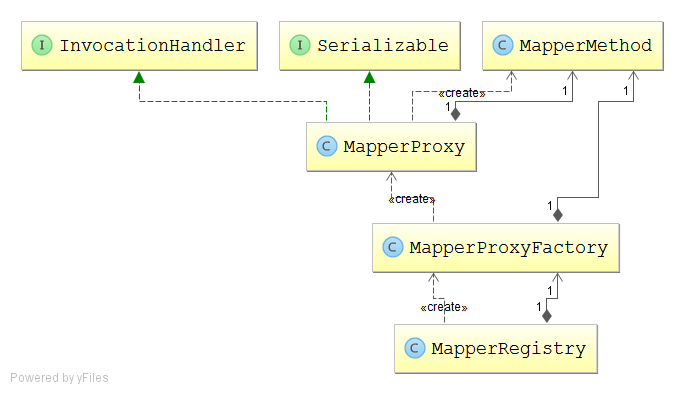mybatis源码分析之mapper动态代理
2016-09-20 12:02
731 查看
上一篇:mybatis源码分析之SqlSession的创建过程
https://my.oschina.net/u/657390/blog/663991
重点分析了SqlSession的创建过程.SqlSession创建成功后:
以上两段代码最终将得到相同的结果.
对比可以发现两段代码不同之处为:
根据sqlSession.selectOne("com.analyze.mybatis.mapper.UserMapper.getUA");
可以想像selectOne会用com.analyze.mybatis.mapper.UserMapper.getUA查找相应的配置,然后执行sql.
接着分析sqlSession.selectOne()
但UserMapper userMapper = sqlSession.getMapper(UserMapper.class);
Map map = userMapper.getUA();这两行代码能够看出一些问题,在代码里并没有实现UserMapper这个接口,也就是说userMapper.getUA();并没实现,最终却能够被调用.那么这到底是怎么实现的呢?
进一步分析源码:
从以上代码可以看出最终调用的是mapperProxyFactory.newInstance()
接着分析MapperProxyFactory的源码
从newInstance里的MapperProxy很容易就可以看出使用了动态代理.
再来看看MapperProxy里的invoke
从以上代码可以看出调用mapper里的接口的时候执行的都是mapperMethod.execute(sqlSession, args);
继续跟进代码会发现上面的例子最终执行的是
可谓殊途同归.
mapper动态代理涉及到的类有MapperRegistry,MapperProxyFactory,MapperProxy,MapperMethod

MapperRegistry的数据源头Configuration.java
MapperRegistry mapperRegistry = new MapperRegistry(this);
XMLConfigBuilder中的方法parseConfiguration()调用mapperElement(root.evalNode("mappers"));
mapperElement()会调用addMapper()最后将数据添加到MapperRegistry中的knownMappers
分析完源码可以仿照以上代码来实现自己的功能:
https://my.oschina.net/u/657390/blog/663991
重点分析了SqlSession的创建过程.SqlSession创建成功后:
String resource = "com/analyze/mybatis/mybatis-config.xml";
InputStream inputStream = Resources.getResourceAsStream(resource);
SqlSessionFactory sqlSessionFactory = new SqlSessionFactoryBuilder().build(inputStream);
SqlSession sqlSession = sqlSessionFactory.openSession();
Map map = sqlSession.selectOne("com.analyze.mybatis.mapper.UserMapper.getUA");
sqlSession.close();
String resource = "com/analyze/mybatis/mybatis-config.xml";
InputStream inputStream = Resources.getResourceAsStream(resource);
SqlSessionFactory sqlSessionFactory = new SqlSessionFactoryBuilder().build(inputStream);
SqlSession sqlSession = sqlSessionFactory.openSession();
UserMapper userMapper = sqlSession.getMapper(UserMapper.class);
Map map = userMapper.getUA();
sqlSession.close();以上两段代码最终将得到相同的结果.
对比可以发现两段代码不同之处为:
Map map = sqlSession.selectOne("com.analyze.mybatis.mapper.UserMapper.getUA");
UserMapper userMapper = sqlSession.getMapper(UserMapper.class);
Map map = userMapper.getUA();根据sqlSession.selectOne("com.analyze.mybatis.mapper.UserMapper.getUA");
可以想像selectOne会用com.analyze.mybatis.mapper.UserMapper.getUA查找相应的配置,然后执行sql.
接着分析sqlSession.selectOne()
DefaultSqlSession.java
public <T> T selectOne(String statement) {
return this.<T>selectOne(statement, null);
}
public <T> T selectOne(String statement, Object parameter) {
// Popular vote was to return null on 0 results and throw exception on too many.
List<T> list = this.<T>selectList(statement, parameter);
if (list.size() == 1) {
return list.get(0);
} else if (list.size() > 1) {
throw new TooManyResultsException("Expected one result (or null) to be returned by selectOne(), but found: " + list.size());
} else {
return null;
}
}
public <E> List<E> selectList(String statement, Object parameter) {
return this.selectList(statement, parameter, RowBounds.DEFAULT);
}
public <E> List<E> selectList(String statement, Object parameter, RowBounds rowBounds) {
try {
//从配置中获取statement信息
MappedStatement ms = configuration.getMappedStatement(statement);
//调用执行器
return executor.query(ms, wrapCollection(parameter), rowBounds, Executor.NO_RESULT_HANDLER);
} catch (Exception e) {
throw ExceptionFactory.wrapException("Error querying database. Cause: " + e, e);
} finally {
ErrorContext.instance().reset();
}
}但UserMapper userMapper = sqlSession.getMapper(UserMapper.class);
Map map = userMapper.getUA();这两行代码能够看出一些问题,在代码里并没有实现UserMapper这个接口,也就是说userMapper.getUA();并没实现,最终却能够被调用.那么这到底是怎么实现的呢?
进一步分析源码:
DefaultSqlSession.java
public <T> T getMapper(Class<T> type) {
return configuration.<T>getMapper(type, this);
}
Configuration.java
public <T> T getMapper(Class<T> type, SqlSession sqlSession) {
return mapperRegistry.getMapper(type, sqlSession);
}
MapperRegistry.java
public <T> T getMapper(Class<T> type, SqlSession sqlSession) {
final MapperProxyFactory<T> mapperProxyFactory = (MapperProxyFactory<T>) knownMappers.get(type);
if (mapperProxyFactory == null) {
throw new BindingException("Type " + type + " is not known to the MapperRegistry.");
}
try {
return mapperProxyFactory.newInstance(sqlSession);
} catch (Exception e) {
throw new BindingException("Error getting mapper instance. Cause: " + e, e);
}
}从以上代码可以看出最终调用的是mapperProxyFactory.newInstance()
接着分析MapperProxyFactory的源码
public class MapperProxyFactory<T> {
private final Class<T> mapperInterface;
private final Map<Method, MapperMethod> methodCache = new ConcurrentHashMap<Method, MapperMethod>();
public MapperProxyFactory(Class<T> mapperInterface) {
this.mapperInterface = mapperInterface;
}
public Class<T> getMapperInterface() {
return mapperInterface;
}
public Map<Method, MapperMethod> getMethodCache() {
return methodCache;
}
@SuppressWarnings("unchecked")
protected T newInstance(MapperProxy<T> mapperProxy) {
return (T) Proxy.newProxyInstance(mapperInterface.getClassLoader(), new Class[]{mapperInterface}, mapperProxy);
}
public T newInstance(SqlSession sqlSession) {
final MapperProxy<T> mapperProxy = new MapperProxy<T>(sqlSession, mapperInterface, methodCache);
return newInstance(mapperProxy);
}
}从newInstance里的MapperProxy很容易就可以看出使用了动态代理.
再来看看MapperProxy里的invoke
public Object invoke(Object proxy, Method method, Object[] args) throws Throwable {
//当执行的方法是继承自Object时执行this里的相应方法
if (Object.class.equals(method.getDeclaringClass())) {
try {
return method.invoke(this, args);
} catch (Throwable t) {
throw ExceptionUtil.unwrapThrowable(t);
}
}
final MapperMethod mapperMethod = cachedMapperMethod(method);
//最终执行的是execute方法
return mapperMethod.execute(sqlSession, args);
}从以上代码可以看出调用mapper里的接口的时候执行的都是mapperMethod.execute(sqlSession, args);
继续跟进代码会发现上面的例子最终执行的是
sqlSession.selectOne(command.getName(), param);
可谓殊途同归.
mapper动态代理涉及到的类有MapperRegistry,MapperProxyFactory,MapperProxy,MapperMethod

MapperRegistry的数据源头Configuration.java
MapperRegistry mapperRegistry = new MapperRegistry(this);
XMLConfigBuilder中的方法parseConfiguration()调用mapperElement(root.evalNode("mappers"));
mapperElement()会调用addMapper()最后将数据添加到MapperRegistry中的knownMappers
分析完源码可以仿照以上代码来实现自己的功能:
public interface UserService {
Map getUser();
}
public class ServiceProxy implements InvocationHandler {
public <T> T newInstance(Class<T> clz) {
return (T) Proxy.newProxyInstance(clz.getClassLoader(), new Class[]{clz}, this);
}
public Object invoke(Object proxy, Method method, Object[] args) throws Throwable {
if (Object.class.equals(method.getDeclaringClass())) {
return method.invoke(this, args);
}
System.out.println("----proxy----" + method.getName());
return null;
}
}
//测试代码
public static void main(String[] args) {
UserService userService = new ServiceProxy().newInstance(UserService.class);
userService.toString();
userService.getUser();
}
//输出结果
----proxy----getUser
相关文章推荐
- SprignMVC+myBatis整合+mybatis源码分析+动态代理实现流程+如何根据mapper接口生成其实现类
- MyBatis Mapper 接口如何通过JDK动态代理来包装SqlSession 源码分析
- Mybatis3源码分析(21)-Mapper实现-动态代理
- Mybatis3源码分析(21)-Mapper实现-动态代理
- Mybatis源码分析(一)--Mapper的动态代理
- Mybatis3源码分析(21)-Mapper实现-动态代理
- MyBatis 源码分析——动态代理
- Mybatis源码中Mapper的动态代理实现原理
- mybatis源码分析之Mapper代理实现分析
- MyBatis 源码分析——动态代理
- Mybatis源码分析获取Mapper
- 由浅入深分析mybatis通过动态代理实现拦截器(插件)的原理
- MyBatis Mapper 接口如何通过JDK动态代理来包装SqlSession 源码分析
- Mybatis3源码分析(19)-Mapper生成过程-示例
- MyBatis学习记录(3):Mapper动态代理方式开发DAO
- Mybatis3.3.x技术内幕(二):动态代理之投鞭断流(自动映射器Mapper的底层实现原理)
- JDK源码分析——动态代理源码(Proxy类)
- mybatis+spring源码解析(动态代理 spring初始化)
- 动态代理模式2--源码分析
- AOP 动态代理 的 源码分析
